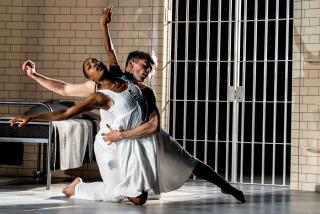AT EL CAMINO : ‘ROMEO’ BY BALLET DE FRANCE
- Share via
Instead of offering yet another ponderous, literal precis of Shakespeare, Gray Veredon’s two-act “Romeo et Juliette” for Ballet de France attempts to reconceive the tragedy’s key elements in fluid dance terms.
Gone is the Prokofiev score, gone, too, the heavy scenery, gesticulating elders, marketplace whores, the endless processions in and out of ballrooms and tombs. Instead, Veredon creates thematic suites, some set to Berlioz’s “dramatic symphony” (played on a dim, scratchy and often capricious tape), others danced in silence.
At Marsee Auditorium, El Camino College, on Wednesday, the lovers met, became involved, married and parted in one unbroken lyric sequence--the specifics of narrative mattering less than the passion the dancing expressed. In another episode, Mercutio’s “Queen Mab” outburst served as both a revelation of his personality and a motivation for a dreamlike corps passage introducing ideas and emotions to be developed later.
Like his impressionistic dramaturgy, Veredon’s choreographic style exploited general effects: clusters of cudgel-wielding men framed by friezes of fearful women in the marketplace, swirling capes and gowns in the ballroom, rapturous lifts in the love duets.
At best, this approach gave familiar events and relationships a youthful directness and urgency; at worst, the movement looked mongrelized: neither ballet nor anything else. However, the prevalent neglect of the classical vocabulary may have been dictated by the obvious limitations of Veredon’s two-year-old Parisian ensemble.
Indeed, the lack of turnout alone suggested that many dancers in Ballet de France may have come very late, or very recently, to ballet. Moreover, falling out of turns and other rough, chancy terminations seemed consistent enough Wednesday to represent a company signature--like “broken” wrists at New York City Ballet.
As Romeo, Eric Languet proved a model partner in the grueling lifts, but an uneven soloist and only a wooden actor. With his distinctive Daniel Day Lewis/”My Beautiful Laundrette” haircut, David Astie made a tolerably nimble, plausibly zesty Mercutio. As Tybalt, Davide Finelli glowered as ineffectually as he danced.
Tiny Elisabeth Amiel made a bold, kittenish Juliet, her ardor keeping the ballet in focus even when (as in the potion solo), Veredon’s determination to use any kind of movement other than classical steps grew highly bizarre.
On the whole, however, Ballet de France lacked emotional involvement in the ballet. The friends of Mercutio and Tybalt carried their “dead” bodies away as if wielding shopping carts. Two corps dancers smirked and snickered through the solemn, full-company reconciliation finale. Do we really need to import this kind of thing?
Ballet de France repeats “Romeo et Juliette” Saturday at Ambassador Auditorium, where it will also present two performances of Veredon’s “A Midsummer Night’s Dream” on Sunday.
More to Read
The biggest entertainment stories
Get our big stories about Hollywood, film, television, music, arts, culture and more right in your inbox as soon as they publish.
You may occasionally receive promotional content from the Los Angeles Times.










